|
1.
History
(From
[1].)
Jagdpanthers were produced between October 1943 and March (April ?)
1945. Worthy of note is that all the Jagdpanthers produced in 1944
were sent to the Western or Italian front.
Most people are probably unaware that there were two different models
of Jagdpanthers: the Ausf.G1 and the Ausf.G2. The latter is mainly
distinguishable by a longer rear deck and a shorter and steeper rear
plate on the fighting compartment.
Even then, modifications during production were numerous:
- October
1943
- The
first Jagdpanthers had the same engine deck as the Panther Ausf.
A but with narrower air intake louvres directly behind the superstructure.
The antenna base was bolted over as the antenna was fitted on
the superstructure. Later this antenna base was no longer present
at all.
- March
1944
- fittings
for rangefinder installed in front of loader's hatch
- April
1944
- hole
for telescoping air tube on engine deck no longer cut in armor
plate.
- two
part gun tube gradually introduced
- May
1944
- tow
coupling fitted, jack moved as a consequence
- June
1944:
-
all vehicles fitted with Nahverteidigungswaffe
- one
driver's visor blanked over and rain guard modifies
- smaller
muzzle brake gradually phased in
- larger
idler wheel (665mm) gradually phased in
- larger
mantlet with external bolts phased in
- Pilzen
fitted on roof (also retrofit)
- July
1944:
- rain
guard over driver's visor dropped
- thicker
roof armor
- extra
cooling pipes for exhaust
- Panther
Ausf.G type rear stowage bins
- August
1944
- September
1944
- October
1944
- rear
stowage bins with vertical stiffeners instead of "X"
possible, but rare
- heat
guards around exhaust
- higher
left engine cooling fan housing with pie shaped segments
- mantlet
with thicker lip
- November
1944
- fume
extractor moved forward on roof on a small number of vehicles
- December
1944
- only
one opening for driver's periscope
- field
modification consisting of covers for the louvres on the rear
deck.
- Flammentöter
exhausts (also as retrofit)
- January
1945 (?)
- Ausf.
G2:
- Longer
engine deck with Panther Ausf.G features;
-
steeper rear of fighting compartment;
- same
overall length as G1;
- twin
cooling pipes no longer needed.
- End
of production run:
- squared
bases for exhausts
- small
return roller replaced by skid
- cast
drive sprocket cover
Note
that s.Pz.Jg.Abt.654 installed extra stowage boxes on the rear of
the fighting compartment
2. Kit features
- two
part gun tube (04/44)
- tow
coupling fitted (05/44)
- Nahverteidigungswaffe
(06/44)
- Pilzen
fitted on roof (06/44)
- Panther
Ausf.G type rear stowage bins (07/44)
- No
Zimmeritt (08/44)
- higher
left engine cooling fan housing with pie shaped segments (10/44)
- mantlet
with thicker lip (10/44)
- only
one opening for driver's periscope (12/44)
- Flammentöter
exhausts (12/44)
- Ausf.G2
engine deck (01/45)
- Single
exhaust pipes on squared bases (end of production run).
- Standard
cover of drive sprocket.
As the
list above tells us, Revell's kit is consistent with a very late Jagdpanther.
Those that have the kit (or look at the scans of the manual) will
also see that Revell tries to give us the option of building it as
an early Jagdpanther, with early mantlet, monobloc gun, triple exhaust
pipes and low ventilator cover. Unless the modeler wants to change
the engine deck and the slope of the rear of the fighting compartment,
these are features that are not compatible with an Ausf.G2. (The early
mantlet is too square anyway.) It also means that one of the marking
options cannot be built from this kit.
What could be used are the early exhausts, if the extra cooling pipes
are removed, to give us a somewhat earlier Jagdpanther with a rounded
base for the exhausts.
Note
that the kit has the fume extractor in the right middle of the roof
top, as most vehicles had. It does not have either a skid or a small
return roller behind the drive sprocket.
We've
not mentioned the idler wheel in the list. It will soon become clear
why.
_t.jpg) _t.jpg) _t.jpg) _t.jpg)
_t.jpg) _t.jpg) _t.jpg) _t.jpg)
Pictures
taken from Henk
of Holland, used with permission. Last picture are marking options
of 2010 re-release.
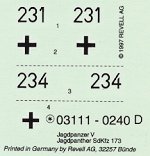
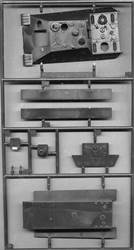 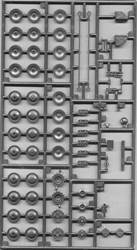 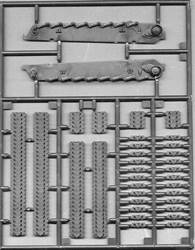 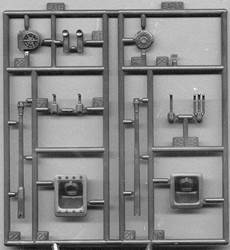
3.
Accuracy
Many
people have discussed the scale accuracy of the kit, even going as
far as saying that the boxtop says "1/72" so it must be
1/72 or that it must be correct because it is the same size as other
kits marketed as 1/72.
To dispel rumours, myths and slander, the kit was extensively measured
against plans in [1], generally considered as the most accurate available.
We've carefully verified that measurements were made at exactly the
same spot.
If our conclusions are not correct, we would like to hear them from
our readers, preferably by sending us a message. (We don't read every
forum, bulletin board or Facebook page on a daily basis, and it's
just that bit more polite.) We guess that the people from Panzer Tracts
would like to hear these conclusions as well, as they take the accuracy
of their work (and especially their drawings) VERY seriously.
| |
Kit
dimensions (mm) |
Kit
dimensions multiplied by 72 (mm) |
Dimensions
from [1] (mm) |
Actual
kit scale
(1/...) |
Track
width
|
9.10 |
655.2 |
660.0 |
72,53
|
Track
pitch
|
3.00 |
216.0 |
193.0 |
64,33
|
Roadwheels
(diameter)
|
11.7 |
842.4 |
870.0 |
74,36
|
Sprocket
(diameter)
|
11.5 |
828.0 |
860.0 |
74,78
|
Idler
(diameter)
|
7.60 |
547.2 |
665.0 |
87,50
|
Gun
barrel length
|
53.48 |
3850.6 |
3944.5 |
73,76
|
Hull
sides (length)
|
87.38 |
6291.4 |
6265.0 |
71,70
|
Hull
length (from tip of nose to rear tow hook)
|
90.27 |
6499.4 |
6680.0 |
|
Engine
deck length
|
25.02 |
1801.4 |
1802.5 |
72,04
|
Engine
deck width
|
34.27 |
24.67.4 |
2555.0 |
74,56
|
Roof
length
|
32.88 |
2367.4 |
2390.5 |
72,70
|
Roof
width (widest point)
|
27.11 |
1951.9 |
2011.8 |
74,21
|
Height
of superstructure (at rear of fighting compartment, perpendicular
to ground)
|
19.06 |
1372.3 |
1286.2 |
67,48
|
Height
of rear plate fighting compartment (parallel to plate)
|
10.85 |
781.2 |
831.2 |
76,61
|
Height
of engine compartment (side plate at heighest point, perpendicular
to ground)
|
8.76 |
630.72 |
609.3 |
69,56
|
Width
of rear plate (bottom)
|
23.40 |
1684.8 |
1860.6 |
79,51
|
| Width
of rear plate (widest point, i.e. width of hull) |
42.90 |
3088.8 |
|
76,89 |
As can
be read from the table, the kit is, in general, 1/72 to 1/76. The
most noticeable scale error is the idler. (It's even too small for
the earlier, smaller idler). The track pitch and height, on the other
hand are too big.
While the roof and engine deck length might give the impression that
the kit is 1/72, the glacis is too steep, creating a length that is
closer to 1/74. The typical angle of the rear of the fighting compartment
found in the Ausf.G2 is correct however.
Given that the height of the fighting compartment is too low and the
overall length of the hull is too high, the side view of the kit gives
a distorted view.
Not mentioned
in the table above is that
- In
general the layout of the detail is accurate.
- The
track faces are accurate.
- The
number of bolts on the roadwheels is accurate.
- The
sprocket has 14 instead of 17 teeth, due to the oversized track
pitch.
- The
small return roller or skid is missing behind the sprocket.
.jpg)
A comparison with other kits can be found here.
References:
[1] Panzer
Tracts No9-3 "Jagdpanther". T.L. Jentz & H.L. Doyle,
2005
Preview
sample purchased by the author.
Revell kits can
be purchased from

|
_t.jpg)
_t.jpg)